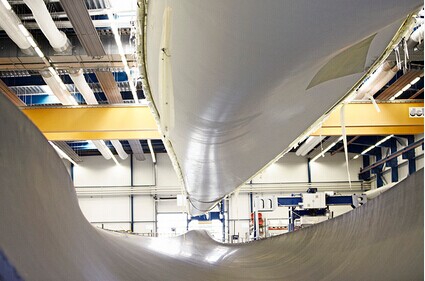How are companies keeping production costs downs as blade sizes increase?
Published on:08 Sep,2015
LM Wind Power’s customized blade-assembly process ensures a lean and efficient manufacturing operation.
Blades are getting longer as developers demand more power from current turbine platforms. To move the trend along, the Department of Energy recently offered up $1.8 million dollars in funding for the development of 60-m long (or more) wind-turbine blades on turbines that stretch over 120 m from base to hub.
The challenge for blade-manufacturing companies is clear: increase a turbine’s energy output with larger blades while somehow keeping production and maintenance costs in check.
Rotor sets are arguably one of the most influential pieces of the energy equation, because larger blades contribute to increased annual energy production or AEP, according to Alexis Crama, LM Wind Power’s VP of Offshore Development. “It’s important to invest in material and process innovation to enable longer and more efficient blade designs,” he said.
Crama pointed out that blade size also matters when it comes to an important industry goal: reducing energy costs. “Another part of the recipe for success is working through efficient and affordable manufacturing set-ups, based on high volumes of larger turbines and longer turbine blades,” he added.
However, the first manufacturing constraint in producing longer and better performing blades is often factory size. The demand for greater blade sizes often exceeds the physical constraints of existing facilities. One answer to this energy-production challenge?
“A focus on innovation in manufacturing technology to enable better capacity utilization,” said Crama. “On the one hand we are continuously sharpening our blade technology, including aerodynamics and system integration, while on the other we are developing highly flexible and efficient industrialization set-ups to deliver quality turbine blades.”
Building longer blades presents unique design challenges, which involves re-thinking materials, structure, and other features. For example, a new hybrid carbon and glass-fiber blade was recently commercialized that extends blade length without compromising weight.
“Implementing this new hybrid material could have been costly because carbon fiber is more expensive than glass fiber,” said Crama, “But the hybrid design provided flexibility to, for the most part, use existing manufacturing processes, thereby reducing the cost of industrialization.”
Longer blades have also posed unique transportation challenges because they are too large for trucks to transport on most roads.
“Today’s blades are more prone to the effects of wear and tear than most other turbine components,” shared Jatin Sharma, Head of Business Development at insurance company GCube. “And this includes additional factors, such as the harshness of the environment and the potential for damage during transportation.”
Modular blades provide one answer to the transportation challenge. The segmented blade design provides for onsite assembly through a reliable bolted joint or a fusion system. This avoids the need for expensive cranes and specialized trucks because the blades are transported in separate parts.
Once on site and fully constructed, turbine downtime is another potentially costly concern wind-turbine owners try to avoid. A 2014 report from GCube, estimated that there are 700,000 wind turbine blades in operation globally, with around 3,800 blade-failure incidents per year. According to Sharma, blades have the highest failure rate of any wind-turbine component and the problems are not age related.
The report categorizes the common causes of blade failure, from lightning damage to human error to manufacturing defects.
“As the wind industry looks to attract secondary investments from pension and fund-management communities, blade failure and the associated business interruption costs—exacerbated by the growing cost pressures on manufacturers—can be an unwelcome deterrent,” said Sharma.
He added that it’s important to implement checks and reviews throughout a blade’s manufacturing process, and through transportation and construction. “Ultimately it’s in the interests of all parties to minimize unscheduled downtime, along with the frequency and severity of turbine failures.”